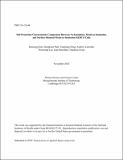Self-Protection Characteristic Comparison Between No-Insulation, Metal-as-Insulation, and Surface-Shunted-Metal-as-Insulation REBCO Coils
Author(s)
Kim, Junseong; Park, Dongkeun; Dong, Fangliang; Lanzrath, Andrew; Lee, Wooseung; Bascuñán, Juan; Iwasa, Yukikazu; ... Show more Show less
Download22ja044_full.pdf (1.019Mb)
Metadata
Show full item recordAbstract
The metal tape co-winding or a metal-as-insulation (MI) winding method is an excellent way to improve the mechanical properties and reduce the average current density, thereby decreasing the stress in high-field REBCO magnet without completely losing the benefits of the no-insulation (NI) winding method. However, the MI winding increases the resistance between turns, which is known as characteristic resistance. The increased characteristic resistance can reduce the bypass current during abnormal transition situation, such as quench, which may not be desirable from a magnet protection point of view. To take advantage of both the MI and NI winding, one possible solution to reduce characteristic resistance of the MI winding coils is to add a shunt on top of the winding surface of the coil. We call this method surface-shunted-metal-as-insulation (SSMI). In this presentation, we compare the characteristic resistances and their correlated selfprotecting characteristics between NI, MI, and SSMI. We present the test results of single pancake coils which wound using different winding methods (NI, MI, and SSMI) with same winding pressure of 20 N. In particular, we investigated how the SSMImethod affects the characteristic resistance.
Description
Submitted for publication in IEEE Transactions on Applied Superconductivity
Date issued
2022-11Department
Massachusetts Institute of Technology. Plasma Science and Fusion CenterJournal
IEEE Transactions on Applied Superconductivity
Publisher
IEEE
Other identifiers
22ja044